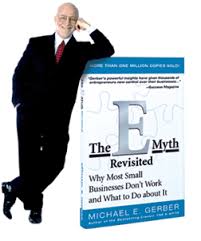 In today’s crowded marketplace, businesses need a competitive edge to be successful. Yet thousands of small businesses fail each year. According to Michael Gerber, Founder and Chairman of E-Myth Worldwide, much of that failure is the result of letting commonplace assumptions get in the way of running a business. Gerber, also the author of E-Myth Mastery: The Seven Essential Disciplines for Building a World-Class Company (2004) and other books, debunks the entrepreneurial myth and offers sound advice for small business owners in this interview with HP’s Technology at Work (TAW).
In today’s crowded marketplace, businesses need a competitive edge to be successful. Yet thousands of small businesses fail each year. According to Michael Gerber, Founder and Chairman of E-Myth Worldwide, much of that failure is the result of letting commonplace assumptions get in the way of running a business. Gerber, also the author of E-Myth Mastery: The Seven Essential Disciplines for Building a World-Class Company (2004) and other books, debunks the entrepreneurial myth and offers sound advice for small business owners in this interview with HP’s Technology at Work (TAW).
(For more information on Gerber’s books and other resources for small businesses, visit E-Myth Worldwide.)
TAW: What is the E-Myth, and why does it lead to the failure of many small businesses?
Michael Gerber: The E-myth is the entrepreneurial myth, and it essentially says that people who go into business for themselves are not the entrepreneurs we’ve come to believe them to be, but what I have ended up calling technicians suffering from an entrepreneurial seizure. So the cook opens up a restaurant, the technology person a software company, and so forth. Each of them believes that because they know how to do the work of the business they understand how to build a business that does that work. In fact, knowing how to do the technical work of the business is the least important part of creating a truly entrepreneurial enterprise. (The work of the technician is the tactical work that’s being done in any company, anywhere.)
TAW: You talk about the fact that a lot of high tech-tech companies are particularly susceptible to common mistakes that contribute to the failure of small businesses. Can you explain?
Michael Gerber: I founded my company, E-Myth Worldwide, in 1977. Since that time we have worked with, coached, consulted and trained over 30,000 small business clients. Many of them come to us from the technology arena. They become enormously consumed by the work they do; they become their business. So the technician who services computers or develops software or manages the network or is driven by the most technical of questions, considerations and concerns–and most often is incapable of seeing the whole picture.
The entrepreneur is a holistic thinker, a systems thinker. He or she is the one who sees the whole instead of the parts. The technician is so consumed by “doing it, doing it, doing it,” that they often miss the whole picture, and don’t even know there is one. More than that, they don’t even care to hear it. They’re very consumed with what they do, and very uninterested in the relationship between what they do and everyone else. So they’re prone to exaggerate the importance of what they do and, in the process, demean everyone else.
TAW: What kind of advice do you have for someone who sees themselves in that person?
Michael Gerber: If you’re going to create a business, your job is to go to work on that business, not in it. So the direction to Sarah (the woman I take through this process in E-Myth Mastery and E-Myth Revisited who’s the owner of a company called All About Pies) is to stop. You immediately know something’s wrong — everybody does. In the process of stopping, remove yourself from everything for the moment — from what you do, from solving problems, from the work of your business. Just stop and get out of there, and begin the process of asking the very seminal question in relation to this business you’ve created: “So what do I want? And what do I want for my life that this business is going to be asked “required” to give me?”
The minute somebody does that, something shifts. Typically, what they’ll discover is that they don’t have the patience to do that. The entrepreneur in them wants to do that, but the technician doesn’t. All the technician wants to do is get to work. So I’m saying to the technician, ‘Stop, sit back, create some room for the rest of you.”
In E-Myth I talk about the three different personalities: the technician, the manager and the entrepreneur. It’s only through the entrepreneur and the manager coupled with the technician that you will ever be able to truly explore and discover this rich, extraordinary opportunity that owning a business of your own can provide, that can actually liberate you. You can own a company and be working a quarter as hard as you’re working today (of course, that’s a generalization) and get 50 times more. That’s possible, but only if you’re willing to stop and start over again.
TAW: In “E-Myth Master”, you write that the franchise prototype can be a helpful model for small businesses. Can you explain?
Michael Gerber: A franchise prototype is the model for a successful expansion. To build a successful franchise, one needs to work through all of the intricacies of a business operating system. This system is inclusive of the brand, the positioning, the “how we do it here,” so that one can organize that small company to such a degree that it can be replicated faithfully. If you were to work on your business as though you were going to franchise it (whether you’re going to replicate the business is irrelevant), you’d begin to see that, “This is how we sell it here, this is how we deliver it here, this is how we manage the cash flow here.”
I go to work on this small business so I can replicate how to do everything faithfully in the hands of other people. The system enables us to develop a sense of integrity in the operation of this business. It’s that sense of integrity that’s missing in so many businesses. They’ve become “people-dependent” as opposed to “systems-dependent.”
TAW: Do you have suggestions for the small-business person about how to access information regarding potential customers that will guide them in developing a marketing strategy?
Michael Gerber: First, you have to understand who your central demographic model consumer is. That’s achieved by asking questions of every person who comes into and has come into your company. Those questions take into consideration age, sex, marital status, education, the kinds of products they buy, etc. Psychographics is about why they buy. There’s a rich treasure trove of stuff you can determine about how people make decisions, and E-Myth Mastery provides that for anyone interested in nailing it down. Once I know who buys and why they buy, I can build a model of my customer.
Then I need to go to geographics. Every business has a trading zone, and it’s very easy to determine. Take a map of where you are and identify, with a pin prick, each and every customer you can. You’ll see a cluster of dots; that’s your trading zone. Draw a perimeter around that and see all of the zip codes where your current customers come from. Then you can get a list that matches your demographics and identify where the people you haven’t done business with are in that trading zone. Now you can talk to people who match your model.
TAW: When people step back and get a broader perspective, do you find that they’re successful?
When somebody is internally motivated to change their life and they engage in the process I’ve described — stop, look, listen, ask what it is you really want before you ask what your business is going to do — it’s transformational. E-Myth is about seeing clearly and as HP says “Invent” opening up the channels to invent. When you’re always working, working, working, there is no one home to invent, there’s no room to invent, there’s no opportunity to connect with the inventor. But when you learn how to take on this new role with yourself and organize it differently, invention happens on its own.

 Chris’ combination of academic credentials, career experience and temperament ideally suit his calling as a business development advisor. Clients say he has a mind for business and a heart for service.
Chris’ combination of academic credentials, career experience and temperament ideally suit his calling as a business development advisor. Clients say he has a mind for business and a heart for service.